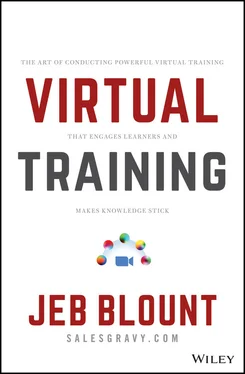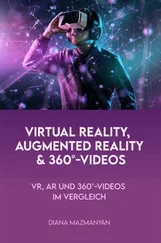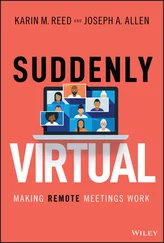What matters most is the way virtual training is delivered and how it makes both the trainer and the participants feel. When the virtual learning experience is emotionally positive:
Participants are more engaged, readily embrace new competencies, and the training sticks.
Participants are more likely to show up to class and be open to future virtual training.
Trainers enjoy their work and gain fulfillment from making an impact.
Leaders book more virtual training and are willing to pay a premium for it.
Organizations blend and integrate VILT into learning and development initiatives.
The real secret to gaining widespread acceptance for virtual training is delivering an exceptional virtual learning experience.
5 The Five Elements of a Legendary Virtual Learning Experience
I acknowledge that human interaction, collaboration, and social learning reach their apex in a dynamic, physical classroom. It's easiest for learners to build an emotional connection—with instructors, with each other, and to the environment—when everyone is physically in the same space. Therefore, to improve the virtual learning experience, our mission and driving focus is creating as close a facsimile to in-classroom training as possible.
First, consider the hallmarks of traditional, old-school virtual training:
The primary visual focus is on PowerPoint slides and screen shares, heavy on bullet points.
The teaching modality is voice-over slides. Typically, the trainer reads the slides to the participants.
The trainer rarely, if ever, shows their face on-screen.
The participants rarely see each other and avoid being seen as much as possible.
There is minimal interaction between the learners and the trainer, and amongst the learners.
Learners rarely interrupt when they have questions or disagreements.
Because the trainer cannot see the participants, he or she is less likely to stop and ask questions based on a learner's nonverbal expressions—questions that could pull concerns to the surface.
Audio and video quality (if the trainers dare show their face) is poor.
There is little on-screen movement or variety to keep learners engaged and visually involved.
Now, consider the elements of a dynamic physical classroom experience:
The visual focal point is the trainer.
Slides and visuals are in the background, typically projected on a screen.
Participants can see the trainer's facial expressions and body language, providing context and additional meaning to words, language, and voice inflection.
The trainer's movement, in front of the class, walking around, and while interacting with students, keeps learners engaged.
Learners can see each other and are more likely to form emotional bonds and feel part of a shared experience. Social learning is maximized.
Participants are more comfortable interrupting and asking questions when they don't understand or disagree.
The trainer can see the participants' body language and respond to unspoken questions, confusion, or disagreement and pull these issues to the surface for conversation.
Training delivery is dynamic, fluid, appropriately nonlinear, and interactive.
Learning is accomplished through breakout sessions, role-plays, interaction, conversation, laughter, and debate.
Designing our new Virtual Learning Experience (VLX) required us to rethink almost everything about how virtual training had been traditionally produced and delivered. Our goal was to bring the most important and engaging aspects of the in-person classroom experience to VLX.
We reimagined the on-screen video experience including: production software, hardware, and processes; video and audio equipment stacks and configuration; virtual training studio design (both professional setups and VLX-certified home studios for our trainers), video conferencing platform integration and mastery, and smoothing out the process of screen sharing, presenting on-screen visuals, and shifting from the main classroom into breakout sessions.
We also focused on the little things, such as getting trainers' faces on-screen and standing up (you would never sit at a desk and deliver training in the classroom); improving trainer eye contact and awareness; getting learners on-screen; creating safe, interactive virtual classroom engagement; running collaborative breakout sessions; and pre-, post-, and inter-class communication.
Finally, we tackled course design, focusing on rethinking visuals and media for on-screen consumption; the chunking, layering, and sequencing of course content; curriculum structure and flexibility; session length consideration; in-class exercises, role-plays, and breakout sessions; inter-class assignments; assessments, trainer-participant communication, and coaching outside the formal classroom; supplemental blended e-learning elements; and leveraging the learning management system (LMS) to enhance and complete the virtual instructor-led training (VILT) experience.
As we experimented, learned, and iterated our process, we landed on the five elements that contribute to a legendary virtual learning experience:
1 Mission and mindset
2 Production
3 Virtual communication skills
4 Design
5 Delivery
We integrated these five elements into our trademarked VLX approach. We redesigned our classroom courses for virtual instruction and honed our virtual training delivery competencies.
Our overriding objective was to create an experience that was so different from the low expectations that most people had for virtual training that it would immediately change perceptions. We wanted people to say “Wow!” the moment they entered our virtual classroom and be excited about coming back for more instruction.
Our mission was to create an experience that engaged learners and helped them grow and develop. We succeeded.
Once we perfected our virtual training processes, the next step was ensuring that the VLX was consistent across all of our deliveries and with all of our trainers.
Consistency matters. The learning experience falls apart if the trainers within an organization are all delivering virtual training at different levels of proficiency and quality.
Therefore, we developed and implemented a standard VLX Studio Equipment and Technology stack, called a Training Tree, and a VLX Trainer Certification. Each of our trainers was required to go through the rigorous certification process in order to continue delivering virtual training. We also added a pay increase incentive once the trainer was certified.
Consistency further improved the quality of our virtual learning deliveries and allowed us to quickly scale up as our clients demanded more and more virtual training. Our clients and their learners loved it. This fresh and innovative approach to virtual training was incredibly close to the in-person experience, and it removed the cost and friction of classroom training (e.g., travel expenses, costs of taking people out of the field, etc.). As a result, many of our clients decided not to go back to the physical classroom.
Now that you understand the potential of VILT, you're ready to learn specific techniques for delivering a legendary virtual learning experience. In Parts 2through 5, I will walk you step-by-step through each of the five elements: mission and mindset, production, virtual communication skills, design, and delivery. My objective is to teach you techniques that turn the virtual classroom into a powerful learning experience, no matter what you teach.
Virtual Training is the most comprehensive and practical resource ever written on virtual training delivery. It will help you master virtual training techniques, engage, and connect with learners in the virtual classroom, and ultimately make virtual training more human. With each new chapter, you’ll gain powerful insights and greater confidence in your ability to deliver successful virtual training.
Читать дальше












